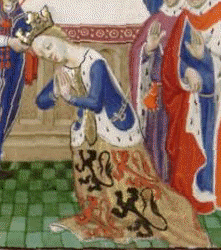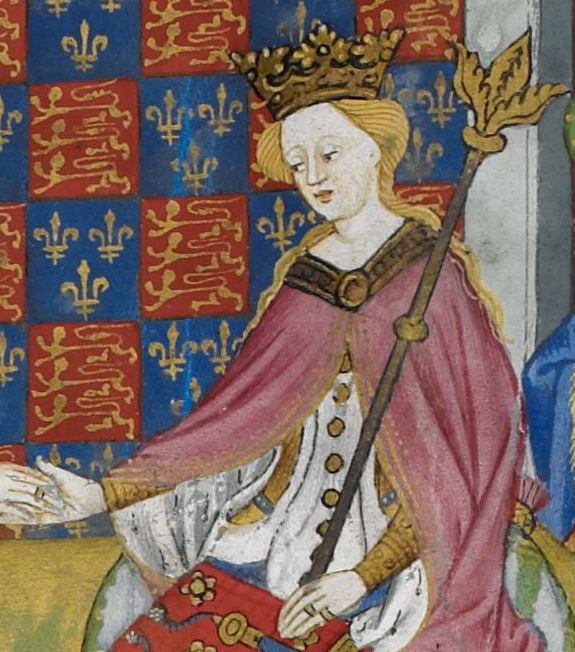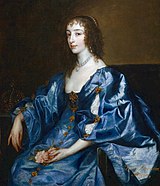
Philippa of Hainault

Philippa of Hainault
For a good chunk of the United Kingdom's history, the choice of a royal spouse and the country they hailed from were matters of critical national importance for a British monarch.

Margaret of Anjou, Henry VI's consort
For this island nation, picking the right spouse was key to building or maintaining vital political alliances with Continental powers. Conversely, marrying the wrong person, without a proper dowry or royal connections, could weaken the legitimacy of the royal lineage and encourage dissent.
Where did these (mostly) women come from? And do their places of origin reveal historic trends?
Let's find out, using data analysis and visualization.
(Note: this timeline starts with the House of Normandy (1066) and ends with the current House of Windsor, a time span of more than 860 years. Records from the Houses of Wessex and Denmark (886-1066) are too complex and unreliable, with dates lost to time and uncrowned consorts of uncertain status. Our analysis starts with the Norman Conquest and ends with Queen Camilla.)
From the get-go, we notice countries bunched together, succeeding themselves. There's a long series of French-born consorts (blue bars) during the first third of the series, a gaggle of English-born spouses (pink) in the middle, and a spate of Germans (orange) in the final quarter.
Several trends are visible:
-- There are no fewer than 10 French women (blue bars) among the first 15
consorts, and 13 among the first 20.
-- But after that number, there is a shift toward English queens (pink bars).
-- And further down the list, a series of six German consorts including Albert of Saxe Coburg
and Gotha.
For most of the middle ages, from 1066 to around 1470, securing a French spouse was the best way for English sovereigns to maintain familial connections with France, with which it was competing for a staggering number of territories.
Most famously, Eleanor of Aquitaine in 1154 brought with her a duchy that was larger than the kingom of France at the time.
In 1170, Margaret of France was picked because her dowry was the much disputed territory of Vexin north of Paris.

Henrietta of France, wife of Charles I
Catherine of Valois' marriage to Henry V in 1420 was part of a plan to eventually place her husband on the throne of France, and thereby end the Hundred Years' War.
When Yorkist King Edward IV secretly wed widowed commoner Elizabeth Woodville in 1464, his relationship with his allies never recovered and more dynastic bloodshed ensued.
Two centuries later, Catherine of Braganza was picked for Charles II in 1660 after her father became the head of Portugal's colonial empire -- and she offered an opportunity for an alliance between the two kingdoms.
Once the United Kingdom adopted a constitutional regime that severely curtailed the monarch's powers, the international importance of a consort diminished.
Of course, royal spouses still had to meet strigents requirements; when young Queen Victoria married Albert, a minor German prince, opposition parties refused to grant him a British peerage.
Queen Alexandra's family had been relatively obscure until 1852, when her father became king of Denmark. She was then deemed an appropriate wife for the future Edward VII, son of Queen Victoria.
Edward VIII found out when he resolved to marry American divorcee Wallis Simpson -- but the monarch's choice of a consort ceased to be a matter of vital international importance.
We've taken a look at the composition and sequence of British royal marriages, but could there be a more qualitative yeardstick? How about total time spent as royal consort? We've got that!
Being a royal spouse can be a lifelong mission (as evidenced by the light blue column on the penultimate spot -- that's Prince Philip, who stayed at his post for 69 years) or evaporate in an instant: many women, even queens, died in labor, and as shown by the extremely short pink bars in the middle of the chart, from Ann Boleyn to Catherine Parr, made the mistake of marrying King Henry VIII to sometimes tragic results.
Given France's front-runner status in the number of British consorts it produced, its dominant position in cumulative tenure time shouldn't be a shock. Still, it is striking that England, with no fewer than 10 consorts, doesn't even reach the 100 year mark and is actually beaten by Germany.
This low total tenure time posted by English consorts clearly illustrates that, for most of history, royal marriages were above all a diplomatic tool aimed at securing the country's international standing in an always insecure world.